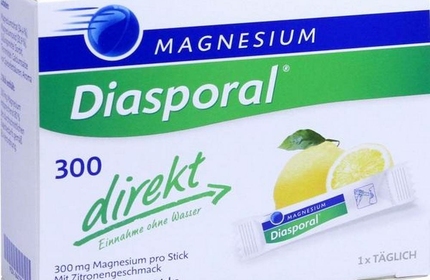 MAGNESIUM DIASPORAL 300. MAGNESIUM DIASPORAL FORTE. CORMAGNESIN
Composition and product form
The active ingredient - magnesium sulfate.
Sterile solutions for intramuscular and intravenous administration. Tablets for dissolution.
MAGNESIUM DIASPORAL 300. MAGNESIUM DIASPORAL FORTE. CORMAGNESIN
Composition and product form
The active ingredient - magnesium sulfate.
Sterile solutions for intramuscular and intravenous administration. Tablets for dissolution.
Pharmacological action
Peripheral vasodilator. It has sedative, hypnotic, general anesthetic, anticonvulsant, antiarrhythmic, hypotensive, antispasmodic, laxative, choleretic, tocolytic.
Magnesium is a physiological calcium antagonist and is able to displace it from binding sites. It regulates metabolic processes, neurochemical transmission and muscle excitability, prevents the entry of calcium ions through the presynaptic membrane, reduces the amount of acetylcholine in the peripheral nervous system and CNS. Relaxes smooth muscles, reduces BP (mostly elevated). When injected, it blocks neuromuscular transmission and prevents seizures; in high doses it has curare-like properties. When administered orally it is poorly absorbed (not more than 20%), increases osmotic pressure in gastrointestinal tract, causes fluid retention and its exit (by concentration gradient) into intestinal lumen, increasing peristalsis throughout its length, leads to defecation (in 4-6 hours). It promotes release of cholecystokinin, irritates duodenal receptors, and has a choleretic effect. The absorbed part is excreted with the urine, with increased diuresis, the rate of renal excretion is proportional to the concentration in plasma. Systemic effects develop 1 hour after intramuscular injection and almost immediately after intravenous injection. Their duration when administered intravenously is θ 30 minutes, when administered intramuscularly 3-4 hours. It passes through the barrier and the placenta, creating concentrations in milk twice as high as in plasma.
Indications
Prophylaxis of hypomagnesemia - inadequate or unbalanced nutrition, taking contraceptives, diuretics, including increased magnesium requirements (growth period, convalescence period, stress, excessive sweating). Acute hypomagnesemia - signs of tetany, impaired myocardial function, seizure syndrome. Complex therapy of cardiac arrhythmias, hypertensive crisis (including with the phenomena of cerebral edema), myocardial infarction, eclampsia, encephalopathy, complex therapy of bronchial asthma, angina pectoris, cardiac arrhythmias (especially supraventricular and caused by antiarrhythmic or diuretic drugs, glucocorticoids or cardiac glycosides), poisoning with salts of heavy metals.
Oral administration mainly for poisoning, constipation, cholangitis, cholecystitis, bowel cleansing, before diagnostic manipulations.
Dosage and administration
Dosing regimen is individual, depending on the indication and the applied dosage form.
Contraindications .
Hypersensitivity, severe bradycardia, AV-blockade, impaired renal function, severe renal failure, myasthenia, respiratory diseases, acute inflammatory gastrointestinal diseases, menstruation.
Side effects
When injected: bradycardia, conduction disorders, diplopia, fever, sweating, hypotension, anxiety, weakness, headache, decreased tendon reflexes, shortness of breath, nausea, vomiting, polyuria. When taken orally: nausea, vomiting, acute inflammation of the gastrointestinal tract.
Overdose
Symptoms: loss of knee reflex, nausea, vomiting, sharp decrease in BP, bradycardia, respiratory and CNS depression.
Treatment: as an antidote, intravenous (slow) calcium preparations (calcium chloride or calcium gluconate), artificial lung ventilation, peritoneal dialysis or hemodialysis, symptomatic drugs are administered.
Drug interaction
Increases the effect of other CNS depressants. Hypotensive drugs increase the likelihood of respiratory center depression. Reduces the effect - administration of calcium salts. Pharmaceutically incompatible (forms precipitate) with calcium preparations, carbonates, bicarbonates and phosphates of alkali metals, hydrocortisone, sodium succinate, polymyxin B sulfate, novocaine hydrochloride, sa-licylates and tartrates.
Specific directions
It is recommended to monitor blood pressure, heart rate, tendon reflexes, renal function and respiratory rate during long-term treatment. If simultaneous intravenous administration of magnesium and calcium salts is necessary, they should be injected into separate veins.